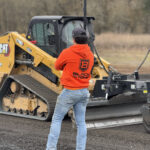
County is Requiring a Paved Access or Approach: What You Need to Know
April 2, 2025If you’re considering getting your driveway or lane paved, you’ve likely encountered some of the common issues asphalt surfaces can develop—whether from online research or firsthand observation of older driveways. With over 15 years of experience in asphalt paving, Blackstone Paving & Excavation has encountered and solved a wide range of asphalt-related problems.
In this article, we’ll cover some of the most common asphalt issues and how you, as the end user, can identify and prevent them. Proper asphalt maintenance and planning can avoid or significantly reduce many of these problems.
Problem 1: Cracks in the Asphalt
Two primary types of cracking occur in asphalt:
- Alligator Cracks (Fatigue Cracks)
These interconnected cracks resemble alligator skin and indicate a deeper issue beyond simple wear and tear. They are typically caused by a weak or improperly installed base, excessive moisture retention, or heavy traffic on thin asphalt. The only effective solution is to remove the damaged asphalt and compromised base, replace it with a properly compacted rock foundation, and repave the asphalt. Depending on the severity, this can be done through localized patching or, in extreme cases, a full-depth replacement.
- Age-Related Cracks
Over time, exposure to temperature fluctuations, moisture, and regular traffic can cause cracks to develop. However, this doesn’t have to become a major issue. Routine maintenance, including crack-filling and seal-coating, can significantly extend the lifespan of your asphalt. Filling cracks as soon as they appear prevents water from seeping in and weakening the base, while seal-coating adds a protective layer against the elements.
Problem 2: Drainage Issues
If you’ve ever driven through a parking lot and splashed into a puddle—or stepped straight into one after parking—you know how frustrating poor drainage can be. Because asphalt is a hard surface, proper drainage planning is essential.
The best solution is grading, which means sloping the asphalt so water naturally runs off the edge. When grading isn’t possible, drains or catch basins must be installed, and the asphalt should be sloped toward them. Asphalt should have a minimum 2% slope to avoid puddling, which translates to just over 1.5 inches of fall per 10 feet. For a 40-foot-wide area where water must drain to one side, that means nearly 7 inches of slope.
Proper drainage planning may impact project costs, often requiring additional material and labor. Be sure your paving contractor has a clear plan for where water will go to avoid puddles and long-term damage.
Problem 3: Asphalt Edges Breaking
Over time, traffic driving over the edge of asphalt can cause it to crack and break apart. Fortunately, this issue is easily preventable from the start by adding a rock shoulder along the edges. This additional support helps prevent cracking.
If your asphalt has already been installed without a shoulder, you can still reinforce it by adding crushed rock along the edges over the following months. However, the best approach is to have your paving contractor include it during installation.
Problem 4: Tree Roots
Tree roots and asphalt don’t mix, and when they clash, the roots always win. If trees are planted too close to the asphalt, their roots will eventually grow underneath and cause issues. Even when roots are deep below the surface, they can lead to cracks, and in severe cases, they can heave the asphalt, creating large bumps.
If tree roots are causing damage, you may need to choose between keeping the tree or dealing with ongoing asphalt repairs. Since roots continuously grow and shift with moisture, the only permanent solution is to remove the tree entirely—though this may not always be desirable.
Additionally, if you plan to pave over an area where a tree was recently removed, ensure all roots and the stump are fully excavated beforehand. Otherwise, as the organic material decomposes, it can create voids beneath the surface, leading to depressions or potholes.
Final Thoughts
Proper planning and preparation are really important to achieving a durable and long-lasting asphalt surface. Often, the difference between a cheap paving job and a higher-quality one comes down to these crucial details. Investing in the right prep work ensures that your asphalt will stand the test of time—so always consider the long-term vision rather than just the upfront cost.



